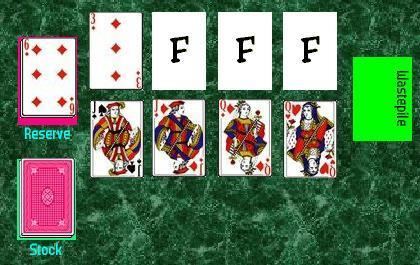Alternative names Demon Deck Single 52-card | Family Demon | |
 | ||
Named variants Chameleon, Rainbow, Selective Canfield, Storehouse, Superior Canfield | ||
Canfield is a solitaire (patience) card game with a very low probability of winning. According to legend, it is originally a casino game, named after the casino owner who is said to have invented it. In England, it is known as Demon.
Contents
The story behind the game
Richard A. Canfield, noted gambler, owned the Canfield Casino in Saratoga Springs, New York during the 1890s. Gamblers at his casino would play the game by "buying" a deck of cards for $50. The gambler would then play the game and earn $5 for every card he managed to place into the foundations; if one was fortunate enough to place all 52 cards into the foundations, the player would win $500. Although players make a loss (about an average of five to six cards), the game proved to be popular, and Canfield became rich. The disadvantage of this new game was the need to hire a croupier for every gambler playing the game.
Canfield himself called the game Klondike, but the name Canfield stuck and became synonymous with solitaire itself. Sometimes, Canfield and Klondike are even interchangeable to refer to each other's games.
Method of play
To play the game, one must first deal thirteen cards faced up and then turned down. These cards would be the reserve, the top card of which is available for play. Then a card is placed on first of the four foundations to the right of the reserve. This card is the first card of its foundation and all other cards of the same rank must also start the other three foundations.
Below the foundations are four piles, each starting with a card each. This will be the tableau and the top cards of each pile are available for play. Cards on the tableau are built down by alternating colors, while the foundations are built up by suit, wrapping from King to Ace if necessary. Any gaps on the tableau are filled from the reserve; in case the reserve is used up, cards from the waste pile are used. Cards on the reserve can also be distributed to the foundations or to the tableau. Cards on the tableau are also moved one unit, provided that the entire column has to be moved.
When no more plays are possible on the tableau and no more cards can be placed to the foundations, especially from the reserve, one can deal cards from the stock (the undealt cards) three at a time into the waste pile and use these cards to build to the foundations or to the tableau. One can make unlimited redeals as long as there are moves.
The game is won when all cards are placed in the foundations. But as Canfield knew very well, winning this game is unlikely, as one can manage to place an average of five to six cards.
See also solitaire terminology.
Variations
Below are some variations to the game:
Solvability
Running a computer solver on 50,000 random Canfield deals has shown that between 71% and 72% of all games are possible to win. In the average game, 40 cards were moved to the foundation. Because the reserve cards are hidden, and because the three-at-a-time dealing of cards from the stock means that cards played early in the game can impact which stock cards are available much later, it is very difficult by normal playing standards to come anywhere near theoretically possible win rates. The highest potential win rates for strategic expert-level players averages at about 35%.
In the Storehouse variant, a greater potential to win increases rates to about 44% proportional to games played. In practice, however, Storehouse is a much easier game. Most players will easily be able to win close to 44% of games, a much higher win rate than is ever achieved by casual players of Canfield.
